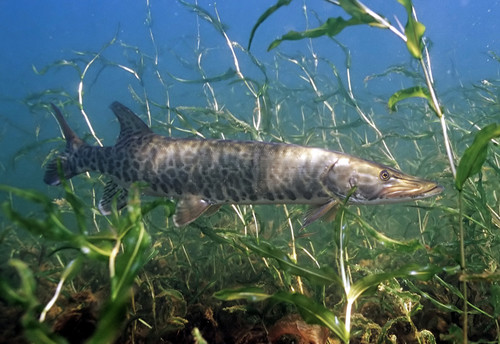
Muskellunge
The Atlantic bluefin tuna (Thunnus thynnus) is a highly migratory, pelagic species renowned for its size, speed, and commercial value. It plays a crucial role in the marine ecosystem as a top predator. Due to its high economic importance, particularly in the sushi market, it has been heavily overfished, leading to significant conservation concerns.
15 30 years
Lifespan
71 - 122 cm
Length
Least Concern
Conservation Status
48 km/h
Swimming speed
Carnivorous
Diet
Local Migration
Migration
Appearance Overview
The Atlantic bluefin tuna is a large, streamlined fish with a metallic blue body and a silvery belly.
Color
Dark metallic blue on top with a silvery underside
Body Shape
Torpedo-shaped, built for speed and endurance
Fins
Two dorsal fins, the first depressible; small, yellow finlets running from the second dorsal and anal fins to the tail
Length
Up to 10 feet (3 meters), commonly 6.5 feet (2 meters)
Weight
Up to 1,500 lbs (680 kg), commonly around 550 lbs (250 kg)
Diet
Carnivorous, feeding on a variety of fish, squid, crustaceans, and eels
Feeding Behavior
Highly active predator, using speed and agility to hunt; often feeds cooperatively, herding prey into tight groups
Social Behavior
Forms large schools, especially during migration; exhibits complex social behaviors and hierarchies
Commercial Relevance
Extremely high value, particularly in the sushi and sashimi markets; one of the most expensive fish species globally
Conservation measures
Subject to international fishing quotas and regulations; ongoing efforts to improve stock management and reduce illegal fishing
Status
Endangered (IUCN)
Threats
Overfishing, driven by high demand in the sushi market; bycatch in other fisheries; climate change impacting prey distribution
Habitat Distribution
Depth Range
0-900 meters, commonly found in the upper layers of the ocean
Geographic Range
Atlantic Ocean, Mediterranean Sea
Preferred Environment
Temperate and subtropical waters, pelagic (open ocean)
Reproduction and Life Cycle
Breeding Habits
Spawns in warm waters, primarily in the Mediterranean Sea and the Gulf of Mexico; spawning occurs in large aggregations
Development Stages
Eggs hatch into larvae; larvae develop rapidly, feeding on plankton; juveniles grow quickly, transitioning to a predatory lifestyle
Fecundity
Females can produce up to 30 million eggs per spawning season
Maturity Age
Matures at 4-8 years in the Mediterranean, and 8-12 years in the western Atlantic
Faqs about Muskellunge
What is the lifespan of an Atlantic bluefin tuna?
Atlantic bluefin tuna can live up to 40 years.
Are Atlantic bluefin tuna warm-blooded?
Yes, they are warm-blooded, able to maintain a body temperature higher than the surrounding water.
Where can Atlantic bluefin tuna be found?
They are found throughout the Atlantic Ocean and the Mediterranean Sea.
Why are they such successful predators?
Their speed, endurance, and warm-blooded nature allow them to thrive in a wide range of temperatures and pursue prey effectively.
Why are Atlantic bluefin tuna endangered?
Overfishing has severely depleted their populations, making them endangered.
How fast can Atlantic bluefin tuna swim?
They can reach speeds of up to 43 mph (70 km/h).
What is the diet of Atlantic bluefin tuna?
They primarily feed on fish, squid, and crustaceans.
When do they reach sexual maturity?
They typically reach sexual maturity between 4-8 years of age.
How many eggs can a female tuna produce?
Females can release millions of eggs during a single spawning season.
What is being done to protect them?
Strict fishing quotas, monitoring of populations, and efforts to combat illegal fishing are key measures.
Copyright @ Nature Style Limited. All Rights Reserved.
 English
English